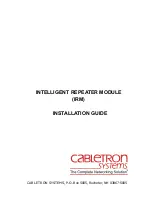
in the center position. This will ensure that at least something gets through the audio circuits and something is
seen on the LCD module.
Only a few simple adjustments are needed to calibrate the input buffers, signal to noise converters and
the TX audio output. If on the test bench, the items needed for alignment are a receiver and a DC voltmeter. If at
the repeater site, only a voltmeter is needed since the receivers are already there. Variable resistors R17-24
control the amplitude of the audio for the input buffer of each input. Moving the control clockwise increases the
signal. It is important to match this as close as possible first to keep from having to compensate for differences
in the noise adjustments. Variable resistors R41-48 control the amplitude of the noise seen by the
microprocessor for each channel. Moving these controls clockwise increases the amount of noise. Variable
resistor R125 is the Audio output adjustment. This is the overall audio adjust that that will go to your
transmitter or controller. R136 is the contrast pot for the LCD module. It should initially be set in the center
position, then adjust for best contrast.
When calibrating the channels, you may want to disable all channels except the one you are working on.
This will prevent any channel from accidentally being selected while calibrating.
Ideally, you would transmit (over the air) different audio tones to all remote receiver and calibrate the
link receivers to have identical signals (in amplitude and frequency content) going to the voter. In the real
world, this may not be possible. Differences in radio equipment may change the audio response for each site.
The calibration procedure described here will give you good performance while maintaining a minimum
amount of time and test equipment required.
First, transmit a 1000 Hz tone at 2.5 KHz deviation to your link receiver. Be sure the link receiver
has a full quieting signal. A touch-tone signal from your handheld radio will work if you don’t have a tone
generator to connect to your transmitter. Adjust the receiver’s volume control and the Audio pot to read 2.0
volts AC on the meter at the audio test point for the channel. The audio test points are next to each
corresponding pot for that channel (they are marked AUD1, AUD2, ect). Check the Silk Screen layout sheet for
help locating these.
Next, with the squelch open and no RF signal on the receiver, adjust the noise test point to read 3.5
volts DC. The noise test points are located between C41-48 and RS-1 and are marked A/D1, A/D2, ect. Repeat
the audio and noise adjustments for the other seven channels.
Once at the repeater site, the adjustments should be close, but you may have to readjust to compensate
for receiver differences. You may want to temporarily connect toggle switches to the disable lines and set the
hysteresis to zero so you can quickly switch back and forth between sites to check for any audible differences
in audio.
Normally, a repeater system should use identical remote receivers and link equipment. This would
ensure that the audio characteristics are nearly the same for each site. If different equipment is used, it may
be necessary to place audio shaping components (such as a 1K resistor in series and .01 uf capacitor to ground
to filter out higher frequencies) in the audio lines to properly match the different audio characteristics.
P e r f o r m a n c e :
The performance from the RVS-8 is excellent. As the QST article stated, when the system is set up and
9











































